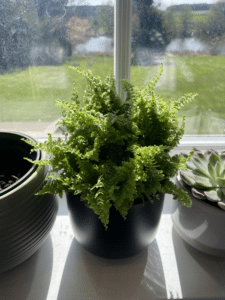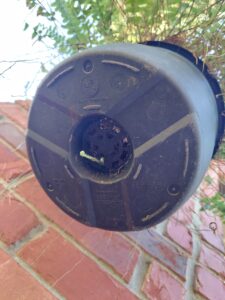From bouquets to gardens, Boston ferns are everywhere. You will see them hanging in almost every restaurant, shopping mall, office, and modern living space. And, sometimes, they make a grand appearance in romantic movies.
With proper growing conditions, they might develop into a massive ball of pretty tendrils in no time. No doubt, Boston ferns need plenty of trims to bring them into a manageable shape and size.
It is pretty easy to trim a Boston fern. Get a pair of scissors and target the unhealthy-looking dried leaves. It is best not to prune the fronds from the top; instead, remove them from the base right at the crown.
Listen to this article here:

Many people on the internet, especially new plant collectors, question if there is anything such as “bad and good trim” when it comes to Boston ferns.
Well, yes, there is. A good trim can enhance the looks and growth of your ferns, while a lousy edge can do just the opposite.
Let me help you give your Boston ferns that refreshing haircut they have waited for!
Table of Contents
Do I Need to Trim the Boston Fern?
Boston fern gets packed in a short time.
The fronds might get leggy and stringy as they get old. Nevertheless, occasional pruning will restore the beauty and vigorous shape of the Boston fern.
It would help trim your Boston fern periodically to give it a good condition and encourage new growth.
The old and dried-up leaves indeed don’t appear very pleasing.
Old fronds look yellow and brown. Sometimes they might lose the tiny green leaflets making them look bare and unsightly. This indicates that your Boston fern is begging you for a trim.
Benefits of Trimming Your Boston Ferns
- Corrects the dull appearances brought about by old fronds
- Encourages fuller growth and removes the leggy and stringy appearance
- More nutrition to the new foliage: The plant sends food to aging and damaged leaves to keep them alive. Removing them will provide more nutrients to the baby fronds.
- Rejuvenates a dying fern
- Removes pests and plant-eaters (if any)
- Improves airflow throughout the fern

When to Trim the Boston Fern?
Technically, you can lightly remove the dead foliage at any time of the year. However, ideal timing is the key when it comes to thorough pruning.
It is best to prune your Boston ferns completely every time you re-pot them.
Trimming your Boston fern at the right time is very important for its healthy growth.
To encourage new and healthy growth, it is best to prune your Boston ferns in early spring.
Or, you can even trim them if you see a new development that disturbs the excellent shape of your fern.
Strictly avoid pruning your Boston ferns starting or during the winter seasons.
The dry fronds protect the base of your Boston fern from winter chills. Let go of that temptation and try to enjoy the brown fronds and the green ones just for a few months.
Important Tip: Do not prune your Boston ferns on scorching and dry weather.
You might stress the plant, causing excessive dehydration due to excessive transpiration.
How to Trim Boston Fern?
Unlike other plants, the Boston fern responds beautifully to severe pruning. I remember pruning my Boston ferns, leaving zero foliage last spring.
And my little pet plant gifted me with a more prolific and bushy growth in no time!
Step 1: Disinfect the Pruning Tools
First, disinfect your scissors or scalpel right before and after each prune. Over time, the pruning tools tend to develop rust and bacteria.
We do not want to give any disease to our ferns, do we?
You can use any disinfectant available at your home. I usually go with rubbing alcohol, and it is as good as any high-end disinfectant!
Step 2: Assess Your Fern
It is not very hard to go overboard with the pruning. And, sometimes, we end up pruning more than 50% of the fern, which is just fine in the case of Boston ferns.
Carefully check the dead, dried, discolored, and diseased leaves. Limit your trim to the unhealthy fronds if you want to preserve the looks!
You can also trim the fronds that appear longer than the rest, disturbing the shape and size of your Boston fern. Well, your ferns do require a good haircut once in a while!
Step 3: Pruning Technique
To create the desired shape, you can trim your Boston fern right from the base or from the top.
Nevertheless, it is recommended to prune the fronds at the bottom and close to the crown. This encourages the growth of new fronds.
Step 4: Do not Forget the Roots
Boston ferns tend to get rootbound before we even realize it. Hence, if you see any roots creeping through the drainage holes or coming out from the topsoil, uproot your fern and trim the roots.

Root-bound Boston ferns appear sickly. Your ferns will seem so much healthier once you have trimmed the roots.
If all the fronds are drying or turning yellow, you can trim them to about 2 inches in length to encourage new growth. After new foliage appears, trim the unhealthy fronds right from the base.
Cut Back Method for Boston Fern
The best time to cut back on Boston Fern is during spring and before winter. The dying fronds will help protect your plant from the chilly winter temperatures by covering the root crown.
Thus, this helps Boston Fern survive throughout the cold of winter and return in the spring in a healthier form.
You can use pruning shears to trim the root if it is too long, or cut it by 4 inches above the soil and store it in a cold and dry place like in a basement or garage.
Thus, cutting Boston Fern will promote more prolific, bushy growth and fix sluggish and leggy growth.
However, there are some drawbacks to cutting Boston Fern significantly during winter if constant heating dries out the air in your house and the temperature changes from the hot or cold air, which can make stress the plant and cause yellow, drooping leaves.
It may look pretty ugly for a few weeks or months, depending on the cut. But don’t panic; it will look worth it in the long run.
Here are some methods of cutting back a Boston Fern;
- Cut off the dead branches that aren’t dead to look disheveled after new plants come in.
- Remove any leaf if infected with scales.
- Chop its root if it is hanging over the pot’s side.
- Cut half of the transplanted fern as it helps it grow well.
- If you don’t like the shape of your plant, then cut the outer border of the leaf to create your desired profile.
This way, you can prune your Boston fern. However, you must avoid pruning right before winter.
Maintenance and Care for Boston Ferns After Pruning
When getting yourself a Boston fern, the first thing to consider is to ensure the environment is a perfect fit for the plant.
Tending to a Boston fern is as easy as ABC; make sure to know its needs.
Here are a few tips and tricks to help you maintain and care for your Boston ferns.

Soil: Boston ferns love damp soil. However, use a well-draining potting mix to avoid root rot. They love a good mixture of cocopeat and moss along with some perlite.
Water: One of the most common reasons for Boston ferns to dry is underwatering. In comparison to other indoor plants, these ferns are heavy drinkers! Water then daily or once in two days, depending upon the season and plant size.
Humidity: Boston ferns love humid air. Please place them in a damp location or mist the fern occasionally. It would be good to invest in a good humidifier if you have one indoors.
Fertilization: Boston ferns are slow feeders. They will do fine without fertilization. However, some organic fertilizers and plant vitamins three to four times a year will work wonders.
Pest infestation: Mealybugs and spider mites love Boston ferns as much as we do. Make sure to spray some organic insecticides every month to eliminate any pests lurking around your beloved plant.
Additional Tips
- Boston ferns love a warm temperature. The ideal temperature would be between 60-70 degrees Fahrenheit.
- Grow your Boston ferns on a hanging basket for a healthy-appearing plant. They love being suspended in the air!
- Remember, Boston ferns (well, actually every kind of ferns) love water!
Conclusion
Your secret to a manageable and exotic Boston fern adorning your living space is all there is.
Just be careful to keep their shape in mind. Nobody likes a bad haircut, not even your ferns!
Boston ferns are one of the low-maintenance plants that would be happy to hang from your ceiling or sit beautifully beside your window.
If you are a busy person, this might be the right pick. Water it right, place it in a terrific bright spot, and trim it once in a while. The rest will all be done by your ferns.
Give that excellent Instagram-able appearance to your Boston fern.
After all, occasional trim hurt no one!


